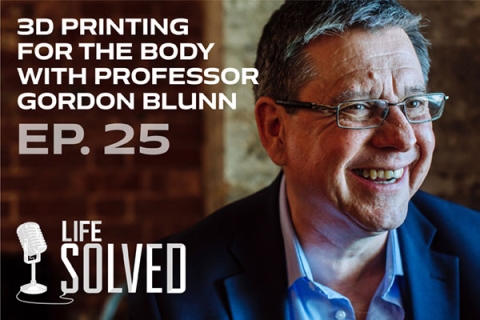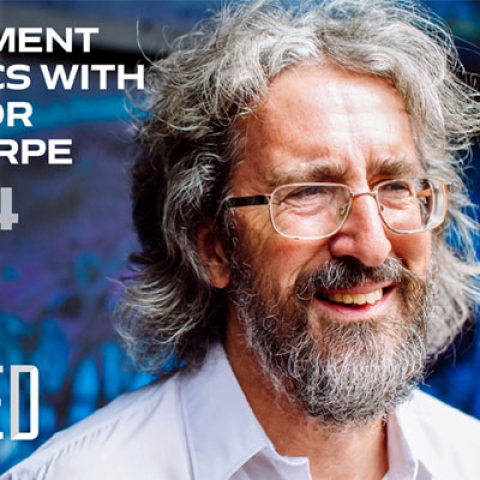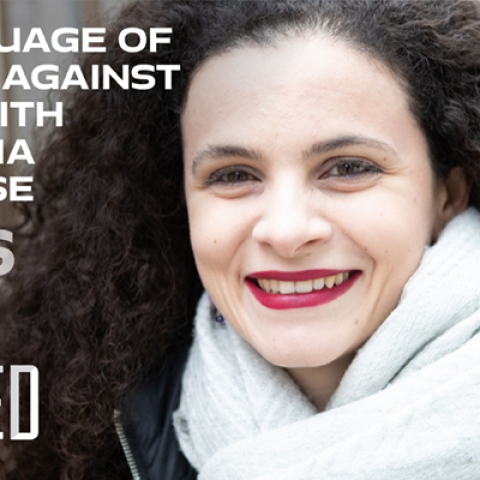

3D printing technology to challenge ill-fitting or uncomfortable prostheses
16 min listen
In this episode of Life Solved from the University of Portsmouth, we hear how the work of Professor Gordon Blunn and his team is revolutionising the way artificial limbs and joint replacements are integrated with the human body.
You can listen to Life Solved on all major podcast players, whether via Apple, Spotify, Google Podcasts or other apps. Just search for 'Life Solved' and press the subscribe button.
Printing new body parts on demand: once this might have sounded like the stuff of science fiction, but a University of Portsmouth project is changing lives using 3D printing technology.
Professor Gordon Blunn leads the University's Health and Wellbeing programme and specialises in the biomedical engineering of the musculoskeletal system.
He's worked out a way to create longer-lasting, replacement bones and joints for bone cancer sufferers and those needing joint replacements. Gordon talks to us in Life Solved, the podcast exploring life-changing ideas from the University of Portsmouth.
Protecting young bone cancer survivors
Professor Blunn was particularly concerned with how to successfully treat children recovering from bone cancer as traditional metal implants can create painful problems for growing bodies.
Some of these patients are really very young and so we need these implants to stay in place for as long as possible and to grow as the patient grows. In the 90s, the success rate for a 10-year-old implant was only 60%. We want these implants to last a lifetime.
Professor Gordon Blunn, Theme Professor (Health and Wellbeing)
Avoiding repeated surgeries for patients is key as success rates lessen with every revision. As a solution, Professor Blunn and the team developed a porous structure that allows tissue and bone to grow through it, making the implant a part of the body’s structure.
Adapting with the body
As life expectancies increase and patients treated with implants can be young, sometimes hip or knee replacements need replacing, as wear and tear creates inflammation. Gordon thinks that by using 3D printing and porous materials, future joint replacements and other implants could not only fit better but also reduce the need for additional operations as time goes by
The new technology is also beneficial to amputees as the 3D printed structures can allow for tissue integration enabling external prostheses to attach directly to the skeleton avoiding the use of a traditional stump-socket device making it more comfortable for the wearer.
Infection is also a risk when using implants, but the team have thought of a way around that too. A ‘glue’ used to incorporate implant into the skeleton has been created using bone cells from the patient and the team is experimenting with incorporating antibiotics into this too.
Where you have implants that become loose there’s often an issue associated with loss of bone so you would actually enhance tissue integration using this glue.
Professor Gordon Blunn, Theme Professor (Health and Wellbeing)
Episode transcript:
Anna Rose: Thanks for downloading this podcast from the University of Portsmouth. Our interviews bring you world-changing ideas and ask the big questions, looking at research taking place here in Portsmouth.
Anna Rose: Today, we meet Professor Gordon Blunn, Theme Professor for Health and Wellbeing and Lead Professor for our University-wide Health and Wellbeing Research theme.
Gordon Blunn: My area of research is in biomedical engineering and in that field we're interested in particularly musculoskeletal engineering and that is associated with mobility and function of the skeletal system, the muscles, the tendons, the ligaments, the cartilage that go to make up that system.
Anna Rose: He's been using research into 3D printing of bones to make real change in the lives of people all over the world – those suffering with bone cancer, needing hip replacements and amputees, amongst others.
Gordon Blunn: 3D printing of bones can be used to develop specific implants for individuals and also be used to enhance ingrowth of bone into metal implants. They can be remarkably successful and transform.
Anna Rose: Gordon and his team have spent a lot of time looking at bone, cartilage, tendons and ligaments. A significant part of their research has been on recovery from bone cancer, particularly in children.
Gordon Blunn: 3D printing is used in the manufacture of prostheses. One of the applications for these prostheses is to treat bone cancers. These bone cancers occur in the shafts of long bones and to treat those cancers, the surgeon has to remove the cancerous bone and replace it with an implant. So in some circumstances, you're looking at replacing over half of a femur, for example, that is also associated with a knee joint replacement as well. In patients that have these big bone cancer prostheses and they're very large implants, fixation to the bone is a problem. And one of the things that we've done is enhance that fixation by having regions on the prosthesis, which are
Previous episode
Next episode
Discover more episodes
Episode 3: Development Economics
23 February 2021
11 min listen

Episode 5: The Language of Violence
9 March 2021
17 min listen

